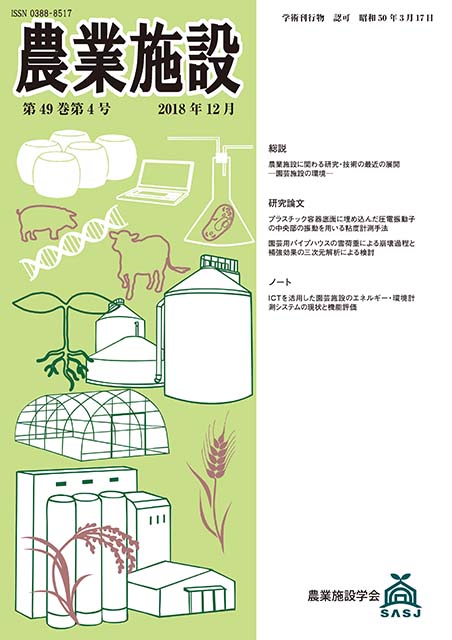All issues

Volume 49 (2018)
- Issue 4 Pages 143-
- Issue 3 Pages 101-
- Issue 2 Pages 59-
- Issue 1 Pages 1-
Volume 49, Issue 4
Vol. 49, No. 4 (Ser. No. 159)
Displaying 1-4 of 4 articles from this issue
- |<
- <
- 1
- >
- >|
-
-Greenhouse Environment and Control-Sadanori SASE2018Volume 49Issue 4 Pages 143-148
Published: 2018
Released on J-STAGE: September 07, 2023
JOURNAL OPEN ACCESSDownload PDF (738K) -
Takahiro ADACHI, Koichi MIZUTANI, Naoto WAKATSUKI, Tadashi EBIHARA2018Volume 49Issue 4 Pages 149-156
Published: 2018
Released on J-STAGE: September 07, 2023
JOURNAL OPEN ACCESSIn this paper, a viscometor suitable for food-processing process is proposed. This viscometer can measure a small amount of liquid, be easy to care, and embed in pipe. This viscometer has disk-shaped piezoelectric resonator embedded in bottom or wall of vessel and pipe. Viscosity is obtained by estimating equivalent circuit parameters of piezoelectric resonator at resonance. To measure viscosity in the case of gluing the circumference of the resonator to the vessel, center of the piezoelectric resonator is vibrated by proposed electrode arrangement. To verify effectiveness of proposed viscometer, the viscometer was made and relationship between resistance Rs obtained by equivalent circuit of piezoelectric resonator and viscosity η of standard liquid of calibrating viscometor was confi rmed. In this confi rming, standard liquid of calibrating viscometor as measurement sample was 10 mL. As a result, radial-mode vibration did not give one-to-one correspondence η and Rs. However, central-mode vibration gave one-to-one correspondence η and Rs, and η was proportional to Rs2 in the range of 9.1 - 478 (mPa・s). Therefore, proposed viscometor can be embedded bottom of vessel, and measure a small amount of sample. Thus, it was shown that proposed viscometor is suitable for food-processing process.View full abstractDownload PDF (1273K) -
Kazuya TAKAHASHI, Yasushi UEMATSU2018Volume 49Issue 4 Pages 157-163
Published: 2018
Released on J-STAGE: September 07, 2023
JOURNAL OPEN ACCESSThe present paper investigates the collapse process of pipe-framed greenhouses under snow loading based on a fi nite element analysis in order to establish more reasonable snow resistant design of these structures. Three snow load distribution patterns under the effects of wind and/or solar radiation are considered. In the analyses, both geometric and material non-linearity are taken into account. Furthermore, the effects of buckling and initial geometric imperfection similar to the buckling mode are also considered. Both 2-D and 3-D analyses are carried out. The effect of reinforcement by adding members on the collapse process is made clear. The result on the collapse process is consistent with the practical damage caused by heavy snowfall. The effects of various reinforcements made on the frame are discussed based on the similar analyses up to the ultimate state. The results show the effective reinforcement methods from the viewpoint of snow resistant design.View full abstractDownload PDF (1710K) -
Ryota TSUCHIYA, Kazuhiro MOCHIDZUKI, Limi OKUSHIMA, Masahisa ISHII, To ...2018Volume 49Issue 4 Pages 164-172
Published: 2018
Released on J-STAGE: September 07, 2023
JOURNAL OPEN ACCESSNumerous types of ICT (Information and Communication Technology) monitoring systems have been developed to help farmers of greenhouse horticulture easily understand the environmental condition within their greenhouses. In addition, these monitoring systems are also effective to optimize the amount of energy required to control its environment. In this paper, the function trends of ICT greenhouse monitoring systems, already commercialized in Japan, are reviewed with respect to monitoring items, functions, installability, and ICT ability and the recently developed ICT energy-environment monitoring system is characterized based on the review. These trends were analyzed using information from websites and catalogues of existing products. The properties of each product were then visually summarized in radar charts using fi ve scores. The radar charts for the new system suggest the need to improve its installability and expand its support functions for farmers.View full abstractDownload PDF (1017K)
- |<
- <
- 1
- >
- >|